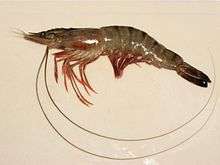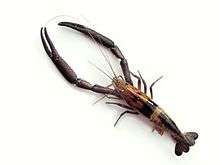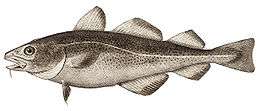Prawn

Prawns are small sea animals with a shell and ten legs (i.e. a member of the order decapoda), that can be eaten.[1]
The term prawn is a common name,[2] used particularly in the United Kingdom, Ireland, and Commonwealth nations, for large swimming crustaceans or shrimp, especially those with commercial significance in the fishing industry. Shrimp that fall in this category often belong to the suborder Dendrobranchiata. In North America, the term is used less frequently, typically for freshwater shrimp. The terms shrimp and prawn themselves lack scientific standing. Over the years, the way shrimp and prawn are used has changed, and nowadays the terms are almost interchangeable.
In the United Kingdom, prawn is more common on menus than shrimp, while the opposite is the case in the United States. The term prawn also loosely describes any large shrimp, especially those at 15 (or fewer) to the pound (such as king prawns or jumbo shrimp).
Shrimp versus prawn
The terms shrimp and prawn are common names, not scientific names. They are vernacular or colloquial terms which lack the formal definition of scientific terms. They are not taxa, but are terms of convenience with little circumscriptional significance. There is no reason to avoid using the terms shrimp or prawn when convenient, but it is important not to confuse them with the names or relationships of actual taxa.[2]
According to the crustacean taxonomist Tin-Yam Chan, "The terms shrimp and prawn have no definite reference to any known taxonomic groups. Although the term shrimp is sometimes applied to smaller species, while prawn is more often used for larger forms, there is no clear distinction between both terms and their usage is often confused or even reverse in different countries or regions."[3] Writing in 1980, L. B. Holthuis noted that the terms prawn and shrimp were used inconsistently "even within a single region", generalising that larger species fished commercially were generally called shrimps in the United States, and prawns in other English-speaking countries, although not without exceptions.[4]

A lot of confusion surrounds the scope of the term shrimp. Part of the confusion originates with the association of smallness. That creates problems with shrimp-like species that are not small. The expression "jumbo shrimp" can be viewed as an oxymoron, a problem that doesn't exist with the commercial designation "jumbo prawns".[5]
The term shrimp originated around the 14th century with the Middle English shrimpe, akin to the Middle Low German schrempen, and meaning to contract or wrinkle; and the Old Norse skorpna, meaning to shrivel up.[6] It is not clear where the term prawn originated, but early forms of the word surfaced in England in the early 15th century as prayne, praine and prane.[7][8][9] According to the linguist Anatoly Liberman it is unclear how shrimp, in English, came to be associated with small. "No Germanic language associates the shrimp with its size... The same holds for Romance... it remains unclear in what circumstances the name was applied to the crustacean."[10]
Taxonomic studies in Europe on shrimp and prawns were shaped by the common shrimp and the common prawn, both found in huge numbers along the European coastlines. The common shrimp, Crangon crangon was categorised in 1758 by Carl Linnaeus, and the common prawn was categorised in 1777 by Thomas Pennant. The common shrimp is a small burrowing species aligned with the notion of a shrimp as being something small, whereas the common prawn is much larger. The terms true shrimp or true prawn are sometimes used to mean what a particular person thinks is a shrimp or prawn.[2] This varies with the person using the terms. But such terms are not normally used in the scientific literature, because the terms shrimp and prawn themselves lack scientific standing. Over the years the way shrimp and prawn are used has changed, and nowadays the terms are almost interchangeable. Although from time to time some biologists declare that certain common names should be confined to specific taxa, the popular use of these names seems to continue unchanged.[2][11]
Regional distinctions
United Kingdom
The terms shrimp and prawn originated in Great Britain. In the use of common names for species, shrimp is applied to smaller species, particularly species that are dorsoventrally depressed (wider than deep) with a shorter rostrum. It is the only term used for species in the family Crangonidae, such as the common shrimp or brown shrimp, Crangon crangon. Prawn is never applied to very small species. It is applied to most of the larger forms, particularly species that are laterally compressed (deeper than wide) and have a long rostrum. However, the terms are not used consistently. For example, some authors refer to Pandalus montagui as an Aesop shrimp while others refer to it as an Aesop prawn.[2][4]
Commonwealth
Commonwealth countries, and Ireland, tend to follow British usage. Some exceptions occur in Australia where some authors refer to small species of Palaemonidae as prawns and call Alpheidae pistol shrimp. Other Australian authors have given the name banded coral shrimp to the prawn-like Stenopus hispidus and listed "the Processidae and Atyidae as shrimps, the Hippolytidae, Alpheidae, Pandalidae and Campylonotoidea as prawns".[4] New Zealand broadly follows British usage. A rule of thumb given by some New Zealand authors states: "In common usage, shrimp are small, some three inches or less in length, taken for food by netting, usually from shallow water. Prawn[s] are larger, up to twelve inches long, taken by trapping and trawling."[11] South Africa and the former British colonies in Asia also seem to generally follow British usage.[4]
United States
Shrimp is the more general term throughout North America, particularly in the United States,[4] where it is used for almost all species.
The term prawn is less commonly used in the United States, being applied mainly to larger shrimps and those living in freshwater.[12]
See also
References
- ↑ "Prawn". Cambridge Dictionary. Retrieved November 27, 2016.
- 1 2 3 4 5 Mortenson, Philip B (2010) This is not a weasel: a close look at nature's most confusing terms Pages 106–109, John Wiley & Sons. ISBN 9780471273967.
- ↑ Chan, TY (1998) Shrimps and prawns In K.E. Carpenter & V.H. Niem. The living marine resources of the western central Pacific. FAO species identification guide for fishery purposes. Rome, FAO.
- 1 2 3 4 5 Holthuis, L. B. (1980) Shrimps and prawns of the world Volume I of the FAO species catalogue, Fisheries Synopsis No.125, Rome. ISBN 92-5-100896-5.
- ↑ Warren S. Blumenfeld (20 November 1986). Jumbo shrimp & other almost perfect oxymorons: contradictory expressions that make absolute sense. Putnam. p. 46. ISBN 978-0-399-51306-0.
- ↑ "Shrimp". Merriam-Webster Online Dictionary. 2008. Retrieved 5 August 2012.
- ↑ prawnOnline Etymology Dictionary. Retrieved 5 August 2012.
- ↑ Prawn Merriam-Webster Dictionary. Retrieved 5 August 2012.
- ↑ Liberman, Anatoly (2012) After ‘shrimp’ comes ‘prawn’ Oxford University Press's Blog, 16 May 2012.
- ↑ Liberman, Anatoly (2012) A scrumptious shrimp with a riddle Oxford University Press's Blog, 18 April 2012.
- 1 2 Richardson LR and Yaldwyn JC (1958) A Guide to the Natant Decapod Crustacea (Shrimps and Prawns) of New Zealand Tuatara, 7 (1).
- ↑ "The American Heritage Dictionary of the English Language, Fifth Edition". Houghton Mifflin Harcourt Publishing Company. 2011. Retrieved 21 May 2013.
Further reading
- Bauer, Raymond T. (2004) "Remarkable Shrimps: Adaptations and Natural History of the Carideans" University of Oklahoma Press. ISBN 9780806135557.
- De Grave, S., Cai, Y. & Anker, A. (2008) "Global diversity of shrimps (Crustacea: Decapoda: Caridea) in freshwater" Hydrobiologia, 595 : 287–293. doi:10.1007/s10750-007-9024-2
- R. Gillett (2008). Global Study of Shrimp Fisheries. Rome, Italy: Food and Agriculture Organization. ISBN 978-92-5-106053-7. Fisheries Technical Paper 475.
- Fransen, C. H. J. M. & De Grave, S. (2009) "Evolution and radiation of shrimp-like decapods: an overview" In: Martin J.W., Crandall K.A., Felder D.L. (eds.), Decapod Crustacean Phylogenetics. CRC Press, pp. 246–259.
- Holthuis, L. B. (1980) Shrimps and prawns of the world Volume I of the FAO species catalogue, Fisheries synopsis 125, Rome. ISBN 92-5-100896-5.
- Kaplan, Eugene H. (2010) Sensuous Seas: Tales of a Marine Biologist Princeton University Press. ISBN 9780691125602.
- Meyer, R., Lochner, S. & Melzer, R. R. (2009) Decapoda – Crabs, Shrimps & Lobsters pp. 623–670 In: Häussermann, V. and Förster, G. (eds) Marine Benthic Fauna of Chilean Patagonia: Illustrated Identification Guide, Nature in Focus. ISBN 9789563322446.
- Poore, Gary (2004) Marine Decapod Crustacea of Southern Australia: A Guide to Identification Csiro Publishing. ISBN 9780643099258.
- Fearnley-Whittingstall, H. & Fisher, N. (2007) The River Cottage Fish Book Page 541–543, Bloomsbury Publishing. ISBN 9780747588696.
- Roberts, Callum (2009) The unnatural history of the sea Island Press. ISBN 9781597265775.
- Rudloe, Jack and Rudloe, Anne (2009) Shrimp: The Endless Quest for Pink Gold FT Press. ISBN 9780137009725.
- Ruppert, E. E., Fox, R. S. & Barnes, R. D. (2004) Invertebrate zoology: A functional evolutionary approach 7th edition, Thomson-Brooks/Cole. ISBN 9780030259821.
- Frederick Schram (1986). The Crustacea. Oxford University Press. ISBN 978-90-04-12918-4.
External links
 Media related to Dendrobranchiata at Wikimedia Commons
Media related to Dendrobranchiata at Wikimedia Commons Media related to Caridea at Wikimedia Commons
Media related to Caridea at Wikimedia Commons- Shrimp versus prawn shrimp,lobster,crab ngrams
-
 Shrimp versus prawns – YouTube
Shrimp versus prawns – YouTube



.png)


